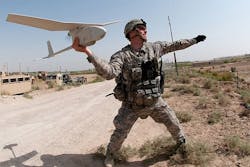AeroVironment to build small UAVs with surveillance and reconnaissance unmanned sensor payloads
Officials of the U.S. Air Force Acquisition Management and Integration Center at Joint Base Langley-Eustis, Va., announced a $13 million contract to AeroVironment on Tuesday for Raven RQ-11B small unmanned aircraft systems.
These unmanned systems are for the U.S. Southern Command Area of Responsibility, which includes Central America, South America and the Caribbean nations. The contract includes UAVs, spares kits, ancillary equipment, and recurring training.
The RQ-11B Raven small hand-launched unmanned aerial vehicle (UAV) is designed for rapid deployment and high mobility for military applications requiring low-altitude surveillance and reconnaissance.
It can be operated manually or programmed for autonomous operation, using the system's advanced avionics and GPS navigation to provide aerial observation, day or night, at line-of-sight ranges to 10 kilometers.
Related: Modular Gimbaled Sensor Payload for RQ-11B Raven small UAV released by AeroVironment
The Raven is available with an optional stabilized gimbaled payload, and delivers real-time color or infrared imagery to the ground control and remote viewing stations. The Raven is the most widely used unmanned aircraft system in the world today, AeroVironment officials say.
Raven unmanned sensor payloads include dual forward- and side-look electro-optical camera nose, electronic pan, tilt, and zoom with stabilization, forward and side-look infrared camera nose.
The UAS has a maximum range of 6.2 miles, mission duration of 60 to 90 minutes, operates at speeds of 17 to 44 knots at altitudes of 100 to 500 feet. The unmanned aircraft is 3 feet long, has a wingspan of 4.5 feet, and weighs 4.2 pounds. It is hand-launched and has a deep-stall landing.
On this contract AeroVironment will do the work in the U.S. Southern Command Area of Responsibility, and should be finished by September 2028. For more information contact AeroVironment online at www.avinc.com, or the Air Force Acquisition Management and Integration Center at www.facebook.com/AirForceAMIC.
Ready to make a purchase? Search the Military & Aerospace Electronics Buyer's Guide for companies, new products, press releases, and videos
